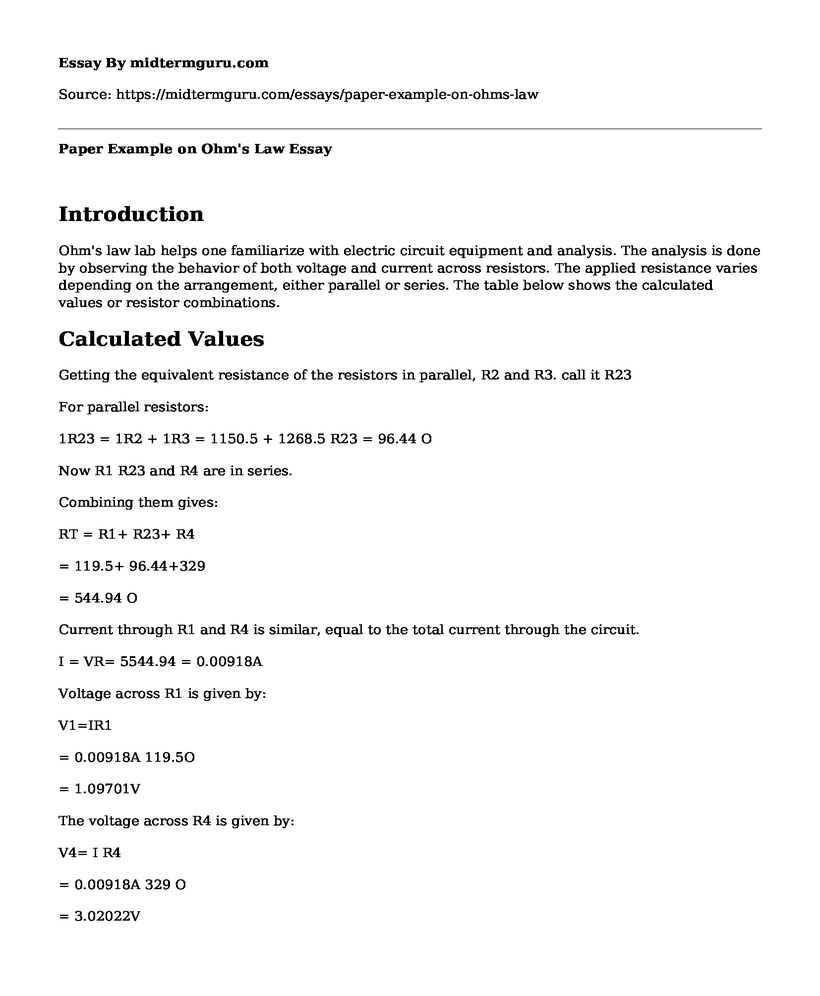Introduction
Ohm's law lab helps one familiarize with electric circuit equipment and analysis. The analysis is done by observing the behavior of both voltage and current across resistors. The applied resistance varies depending on the arrangement, either parallel or series. The table below shows the calculated values or resistor combinations.
Calculated Values
Getting the equivalent resistance of the resistors in parallel, R2 and R3. call it R23
For parallel resistors:
1R23 = 1R2 + 1R3 = 1150.5 + 1268.5 R23 = 96.44 O
Now R1 R23 and R4 are in series.
Combining them gives:
RT = R1+ R23+ R4
= 119.5+ 96.44+329
= 544.94 O
Current through R1 and R4 is similar, equal to the total current through the circuit.
I = VR= 5544.94 = 0.00918A
Voltage across R1 is given by:
V1=IR1
= 0.00918A 119.5O
= 1.09701V
The voltage across R4 is given by:
V4= I R4
= 0.00918A 329 O
= 3.02022V
Therefore, the voltage across the combination R23 is calculated as follows:
V23=VT - (V1+ V4)
= 5V - (1.09701V + 3.02022V)
= 0.88277V
We can now get the current through resistors R2 and R3.
I2 = VR = 0.88277150.5= 0.00587A
I3 = VR = 0.88277V268.5 O = 0.00329A
R1, R2, R3, and R4 are in parallel. The voltage across each resistor is the same, 5V. Total resistance is given by the formulae:
1RT = 1R1 + 1R2 + 1R3 + 1R4 1RT = 1119.5 + 1150.5 + 1268.5 + 1329 1RT = 0.0030395
RT = 329 O
The current in the circuit now is calculated using Ohm's law.
I = VR = 5329 = 0.015198A
I1 = 5119.5 = 0.04184A
I2 = 5150.5 = 0.03322A
I3 = 5268.5 = 0.01862A
I4 = 5329 = 0.015198A
Combining R1 and R2 to give R12
1R12 = 1R1+ 1R2 = 1119.5+ 1150.5 = 0.0150
R12 = 66.6 OCombining R3 and R4
1R34 = 1R3+ 1R4 = 1268.5+ 1329 = 0.00676
R34 = 147.8 O
The two combinations are now in a series. Total resistance becomes:
66.6 O + 147.8 O = 214.4 OV = 5V
The current is thus given by:
I = VR = 5214.4 O = 0.0233A
The voltage across R1 and R2 are equal, same case to the voltage across R3 and R4.
V1 = V2 = 0.0233A 66.6 O = 1.552V
V3 = V4 = 0.0233A 147.8 O = 3.444V
The current through each resistor is calculated below:
I1 = V1R1 = 1.552V119.5 = 0.0130A
I2 = V2R2 = 1.552V150.5 = 0.0103A
I3 = V3R3 = 3.444V268.5 = 0.0128A
I4 = V4R4 = 3.444V329 O = 0.0105A
Combining R1 and R3
R13 = R1 + R3
= 119.5 + 268.5 = 328 O
Now R13 is in a parallel arrangement with R2.
Equivalent resistance REq for the combination becomes:
1REq = 1R13+ 1R2
= 1328 O+ 1329 O = 0.00609
REq= 164.2OThe combination is now in series with R4
Total resistance RT will be given by:
RT = REq+ R4
= 164.2O+ 329O = 493.2 O
Using Ohm's law, the current through the circuit is:
I = VR = 5V493.2 O = 0.0101A
I4 = 0.0101A
The voltage across the resistors R1, R2, R3, and R4 is calculated as follows:
The voltage across R4 is given by:
V4 = IR4
= 0.0101A 329O = 3.332V
The voltage across the combination R1, R2 and R3 is therefore 5V- 3.332V = 1.678V
V2 is therefore 1.678V
I2 = V2R2 = 1.678V329 O = 0.00510A
The current passing through R1 and R3 is the same, equal to:
I - I2
= 0.0101A - 0.00510A
= 0.005A
I1 = I3 = 0.005A
Post Laboratory Questions
The amount of current passing through a resistor varies depending on the value of the resistance. The arrangement of the resistors also determines the amount of current flowing through them. The Current is the same for resistors in series but different in parallel connection.
The sum of the voltage in circuit 1 is essential in determining the total current in the loop.
Experimental values were slightly lower compared to the calculated values.
The difference between the experimental and calculated values could result from the internal resistance of the cell and connecting wires that lower current in the circuit.
A resistor is an electrical component found in many electrical networks mainly used to offer resistance to the flow of current.
The voltage across resistors in parallel connection is the same as opposed to the voltage across resistors in series connection. Total voltage in a circuit with resistors in series is the sum of voltages across each resistor. This makes the calculation of current through each resistor possible.
Conclusion
For a series connection, the current through each resistor is the same, and the equivalent resistance is the sum of individual resistors.
RT = R1+ R2+ R3+ R4
For resistors in a parallel arrangement, the voltage across each resistor is the same. The inverse of the equivalent resistance is equal to the inverse sum of individual resistors.
1RT = 1R1 + +1R2 + 1R3 + 1R4
Cite this page
Paper Example on Ohm's Law. (2022, Sep 20). Retrieved from https://midtermguru.com/essays/paper-example-on-ohms-law
If you are the original author of this essay and no longer wish to have it published on the midtermguru.com website, please click below to request its removal:
- How Diversity Affects Local Feed Yard
- Geography Paper Example: What Is Hong Kong?
- Essay on Complexity Science and Chaos Theory in Healthcare Systems
- Paper Example on Ohm's Law
- Paper Example on Organic Chemistry and Its Differences from Other Branches of Chemistry
- Critical Essay on From Dust to Life: the Origin and Evolution of Our Solar System
- The Earliest Bipedal Hominids: Taung Child & Neanderthals - Essay Sample







